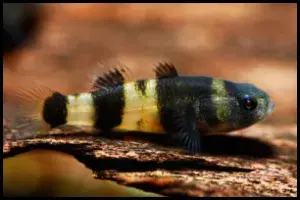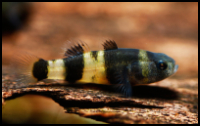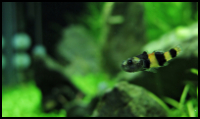



Quick Care Details (Table)
| Livestock Characteristics | Value |
|---|---|
| Care Level | Moderate |
| Temperament | Peaceful |
| Diet | Carnivore |
| Maximum Size | 2 Inches |
| Minimum Tank Size | 10 Gallons |
| Plant Safe | Yes |
| Temperature Range | 75-82°F |
| PH Range | 6.0-7.5 |
| KH Range | 4-8 dKH |
| GH Range | 4-12 dGH |
Species Specific Categories
Helpful Video
Care Details
Aquascape
- Provide a well-decorated aquarium with plenty of hiding spots, as Bumblebee Gobies appreciate caves, driftwood, and plants for cover.
- Utilize rocks, caves, and PVC pipes to create multiple hiding places throughout the tank.
- Make sure the decorations are stable and won't collapse on the fish.
Substrate
- Use fine-grained sand or smooth gravel as the substrate, as Bumblebee Gobies like to sift through it in search of food.
- Avoid using sharp or coarse substrates that can potentially injure their delicate undersides.
- Bumblebee Gobies prefer habitats with soft and sandy substrates.
- They are bottom-dwelling fish, spending much of their time sifting through the substrate in search of food.
Disease prevention
- Maintain good water quality through regular water changes and proper filtration.
- Quarantine any new fish before introducing them to the main tank to prevent the spread of diseases.
- Avoid introducing sick or stressed fish into the tank.
Filtration
- Use a gentle filtration system to avoid creating strong currents, as Bumblebee Gobies prefer calmer water.
- A sponge filter or a low-flow canister filter is often suitable for their needs.
- Regularly clean or replace filter media to maintain optimal water quality.
Lighting
- Provide subdued lighting for the aquarium, as Bumblebee Gobies prefer dimly lit environments.
- Use low-intensity lighting or include floating plants to help diffuse the light and create shaded areas.
Water Flow
- Bumblebee Gobies prefer slow to moderate water flow, as they are adapted to calm, stagnant waters.
- Avoid strong currents in the tank, as it can stress or exhaust them.
- Position the filter outlet or use decorations to break up water flow and create areas of stillness.
Temperament and Behavior
Behavior
- Bumblebee Gobies are generally peaceful and relatively calm fish.
- They spend a significant amount of time near the bottom of the tank, often perching on or near the substrate.
- These gobies have a unique way of swimming, using their pectoral fins to move in short bursts or hover in one place.
- They are not known for being highly active swimmers and prefer slower, more deliberate movements.
Breeding
- Breeding These fish can be challenging in captivity due to their specific breeding requirements.
- Males will build small nests and attract females to lay eggs in them.
- The eggs are adhesive and will be guarded by the male until they hatch.
- Providing appropriate water conditions, including slightly brackish water, and a suitable breeding setup can increase the chances of successful breeding.
Compatibility
- These Gobie are generally compatible with other small, peaceful fish species.
- They should not be kept with aggressive or larger fish that may intimidate or harm them.
- Avoid housing them with fin-nipping or highly active fish that might stress or harass them.
Tankmates
- Suitable tankmates for Bumblebee Gobies include small peaceful fish like other gobies, danios, rasboras, or small catfish species.
- Avoid keeping them with aggressive or territorial fish, as this fish may become targets of aggression.
Activity Level
- Bumblebee Gobies are not particularly active swimmers and spend a significant amount of time near the bottom of the tank.
- They have a slower and more deliberate activity level compared to some other fish species.
- They tend to explore their environment in short bursts and may perch on objects or the substrate.
Clean up Crew
- Bumblebee Gobies are not typically considered part of a clean-up crew in the traditional sense.
- They are not known for actively consuming algae or performing cleaning functions in the aquarium.
- However, they may help control small populations of tiny invertebrates, such as small worms or insect larvae, as part of their natural diet.
Diet and Nutrition
Dry Foods
- Bumblebee Gobies will not readily accept dry foods.
- Some people say they have trained them to accept dry foods, but this is extremely difficult and not a lot term solution.
Frozen Foods
- Bumblebee Gobies readily accept and enjoy various frozen foods.
- Offer frozen foods like brine shrimp, bloodworms, daphnia, and small pieces of frozen mysis shrimp.
- Thaw the frozen food before feeding to ensure the fish can consume it easily.
Live Foods
- Bumblebee Gobies have a natural inclination towards live foods, and they will readily consume small live prey.
- Offer live foods like brine shrimp, daphnia, mosquito larvae, and small worms such as blackworms or tubifex worms.
- Live foods can provide enrichment and help stimulate natural feeding behaviors.
Vegetables
- They will not eat any vegetables.
Algae
- Bumblebee Goby are Carnivores and will not eat any algae.
Tank Parameters
Tank size
- These goby are small fish that do not require a large tank.
- A minimum tank size of 10 gallons (38 liters) can be suitable for a small group or pair of Bumblebee Gobies.
- However, providing a larger tank, such as 20 gallons (75 liters) or more, will offer more swimming space and allow for better territorial separation if keeping multiple individuals.
Tank Length
- The length of the tank is more important than the height for Bumblebee Gobies.
- Aim for a tank with a length of at least 24 inches (61 centimeters) to provide adequate horizontal swimming space for these small fish.
Water Temperature
- Bumblebee Gobies are tropical fish and require relatively warm water temperatures.
- Maintain the water temperature within the range of 75-82°F (24-28°C) to provide optimal conditions for their health and well-being.
- Use a reliable aquarium heater to maintain a stable and consistent temperature.
pH (Acidity/Alkalinity)
- Bumblebee Gobies prefer slightly acidic to neutral water conditions.
- The recommended pH range for Bumblebee Gobies is between 6.0 and 7.5.
- Regularly monitor the pH level and make necessary adjustments using pH buffers or other appropriate methods if needed.
KH (Carbonate Hardness)
- Ideally, aim for a KH level between 4-8 dKH.
GH (General Hardness)
- Bumblebee Gobies can tolerate a range of carbonate and general hardness levels.
- GH level between 4-12 dGH.
Hardiness
- Bumblebee Gobies are generally hardy fish when provided with appropriate care and suitable water conditions.
- They can adapt to a range of water parameters, but it's important to maintain stable and consistent conditions to avoid stress and health issues.
Nitrate (NO3) levels
- Bumblebee Gobies, like most fish, are sensitive to high levels of nitrates.
- Keep nitrate levels as low as possible, ideally below 20 ppm (parts per million).
- Regular water changes, proper filtration, and maintaining a balanced aquarium ecosystem will help control nitrate levels.
Salinity Saltwater Levels
- Bumblebee Gobies are commonly found in brackish water habitats, which are a mix of freshwater and seawater.
- They inhabit estuaries, mangrove swamps, and shallow coastal areas where freshwater rivers meet the sea.
- These fish should not be keep within a full saltwater or marine environment.
- A specific gravity (SG) or salinity level of around 1.005 to 1.008 is often suitable.
- These fish can be keep in a fully freshwater environment long term.
History, Popularity, History and Species Variety Details
The History and Popularity of The Brachygobius Doriae
Bumblebee Gobies, scientifically known as Brachygobius spp., are small fish that belong to the family Gobiidae. The genus Brachygobius comprises several species, including Brachygobius xanthozonus, Brachygobius doriae, and Brachygobius nunus. These fish are native to the brackish and freshwater habitats of Southeast Asia, particularly in regions like Indonesia, Thailand, Malaysia, and Singapore.
The Bumblebee Gobies gained popularity in the aquarium trade due to their unique appearance and interesting behavior. They are named after their striking coloration, which resembles the black and yellow stripes of a bumblebee. Their elongated body shape, large eyes, and fused pelvic fins contribute to their distinct and charming appearance.
In their natural habitat, Bumblebee Gobies are found in shallow coastal areas, estuaries, and freshwater streams. They are euryhaline, which means they have the ability to tolerate a range of salinity levels. They often inhabit environments with sandy or muddy substrates, and their natural diet consists of small invertebrates, worms, and larvae found in these habitats.
The popularity of Bumblebee Gobies in the aquarium hobby can be attributed to their manageable size, interesting behavior, and ability to adapt to different water conditions. These fish are typically small, reaching an adult size of about 1.5 to 2 inches (4-5 centimeters). Their small size makes them suitable for smaller aquarium setups, such as nano tanks or community tanks with other peaceful fish species.
Bumblebee Gobies are known for their unique swimming style, using their pectoral fins to move in short bursts or hover near the bottom of the tank. They are generally peaceful fish but can show some territorial behavior, especially during the breeding season.
In summary, Bumblebee Gobies have a fascinating history rooted in the brackish and freshwater habitats of Southeast Asia. Their striking appearance, small size, and interesting behavior have made them popular among aquarium enthusiasts around the world. With proper care and suitable tank conditions, Bumblebee Gobies can thrive and bring enjoyment to hobbyists as they showcase their unique traits and charming personality.
Back to topMale gender vs Female gender (Sexual Dimorphism)
- Body Shape: Males tend to have a more elongated and slender body shape compared to females, who often have a rounder or more robust body.
- Coloration: In some cases, males may exhibit more vibrant or intense coloration compared to females. They might have more pronounced black or yellow stripes or a more vivid overall appearance.
- Dorsal Fin: The dorsal fin of male Bumblebee Gobies can be larger and more elongated compared to females, particularly during breeding periods. The male's dorsal fin may have more filaments or extensions.
- Size: In some instances, males may grow slightly larger than females. However, the size difference is often subtle and may not be reliable for determining gender.
- Behavior: During breeding or courtship periods, males may display specific behaviors to attract females. They might exhibit vibrant colors, flare their fins, or engage in dances or territorial displays.
- Vent Position: In mature females, the vent (cloaca) located near the anal fin may appear slightly swollen or rounder compared to males. This is a more reliable method for determining gender but may be difficult to observe without close examination.
Breeding The Bumblebee Goby
- Setting up a Breeding Tank: Prepare a separate breeding tank that is appropriately sized, ideally around 10-20 gallons (38-75 liters). Ensure it is equipped with suitable filtration and heating.
- Water Parameters: Bumblebee Gobies prefer slightly brackish water for breeding. Aim for a specific gravity (salinity) around 1.005 to 1.010. Maintain a temperature range of 78-82°F (25-28°C) and a pH level around 7.0-8.0.
- Conditioning the Breeding Pair: Select a healthy pair of Bumblebee Gobies and condition them for breeding. Provide them with high-quality live or frozen foods, such as brine shrimp, bloodworms, or daphnia, to enhance their overall health and reproductive readiness.
- Introducing the Breeding Pair: Transfer the conditioned male and female into the breeding tank. Ensure the tank is well-decorated with caves or other hiding spots for the female to lay her eggs.
- Courtship and Spawning: The male will establish a territory and begin to court the female through various displays, such as fin flaring, dancing, or vibrating movements. The female will respond to these displays if she is receptive. Successful courtship will lead to spawning, where the female releases eggs, and the male fertilizes them.
- Egg Collection: Once spawning occurs, it's crucial to promptly remove the female from the breeding tank to prevent her from eating the eggs. This can be done by carefully scooping her out and transferring her to a separate tank.
- Incubation: The male will guard the eggs, which are adhesive and usually attached to surfaces such as plants or the tank walls. Allow the male to continue guarding the eggs. Provide suitable lighting and maintain stable water conditions during the incubation period, which typically lasts around 7-10 days.
- Hatching and Fry Care: After the incubation period, the eggs will hatch, and the fry will become free-swimming. At this stage, you can start feeding them small live or frozen foods, such as baby brine shrimp or micro worms. Ensure the fry have a well-established food source and provide frequent, small feedings.
- Growth and Development: Continue to monitor the water parameters and provide suitable tank conditions as the fry grow. Gradually introduce larger food options as they mature. Maintain clean water through regular water changes to ensure their health and well-being.
- Separate Juveniles: As the fry grow and develop, they may become territorial and exhibit aggression towards each other. It is recommended to separate them into individual tanks or provide ample space and hiding spots to minimize conflicts.
Frequently Asked Questions
What do Bumblebee Gobies eat?
Bumblebee Gobies are carnivorous fish. They primarily feed on small live and frozen foods, such as brine shrimp, bloodworms, and daphnia. They can also accept high-quality dry foods formulated for small carnivorous fish.
Can Bumblebee Gobies be kept in a community tank?
Yes, Bumblebee Gobies can be kept in a community tank with other small, peaceful fish species. However, it's important to monitor their behavior and ensure suitable tankmate compatibility.
How big do Bumblebee Gobie grow?
Bumblebee Gobies typically reach a size of around 1.5 to 2 inches (4-5 centimeters) when fully grown.
Are Bumblebee Gobie suitable for beginners?
Bumblebee Gobies can be suitable for beginners with some prior experience in fishkeeping. They have specific care requirements, including brackish water conditions, and may require additional attention compared to freshwater fish.
Do Bumblebee Gobie jump out of the tank?
Bumblebee Gobies have the ability to jump, so it's important to have a securely fitted lid on the aquarium to prevent them from leaping out.
Can Bumblebee Gobie live in freshwater?
Bumblebee Gobies are naturally found in brackish and freshwater habitats, but they prefer slightly brackish water conditions for optimal health and well-being.
How long do Bumblebee Gobie live?
Bumblebee Gobie have an average lifespan of around 3 to 5 years with proper care and suitable tank conditions.
Do Bumblebee Gobie require a lot of maintenance?
Bumblebee Gobie have similar care requirements to other small fish species. They require regular maintenance such as monitoring water parameters, performing water changes, and providing a balanced diet. However, they are not considered high-maintenance fish.
Can Bumblebee Gobie be kept with shrimp or snails?
You can keep them with adult shrimp because the fish will be unable to fit the shrimp in their mouth, but fry will be a easy target for dwarf bumblebee gobie. Snails are generally not at risk, due the the shell of protection snails have. so you should not have much concern about having them in the same tank.
Are Bumblebee Gobie aggressive?
Bumblebee Gobie are generally peaceful fish but may exhibit territorial behavior, especially during the breeding season. It is important to provide adequate hiding spots and territories to minimize potential aggression.
Can Bumblebee Gobie change color?
Bumblebee Gobie may exhibit slight color changes based on their mood, lighting conditions, or overall health. For example, they may appear darker or lighter depending on their surroundings and level of stress.

